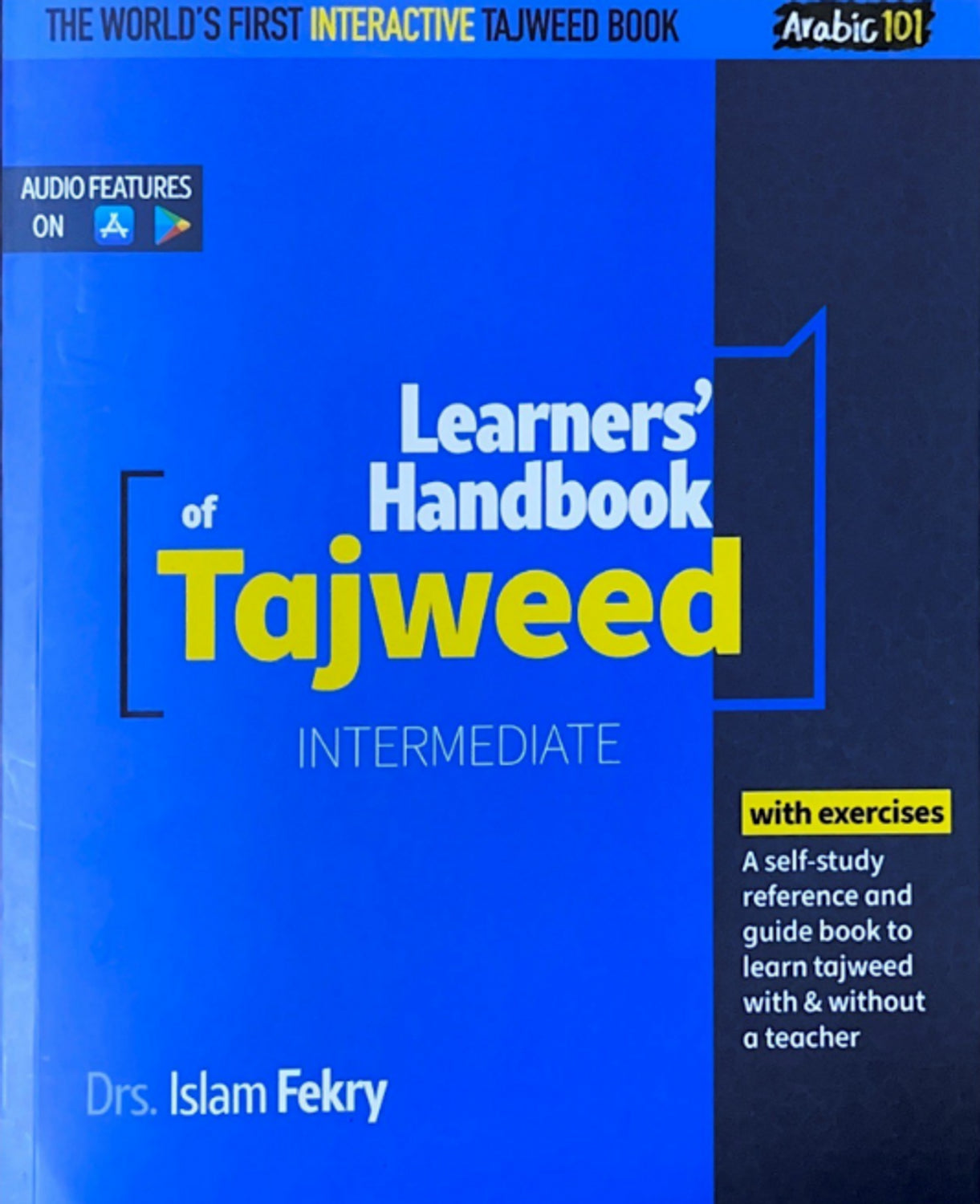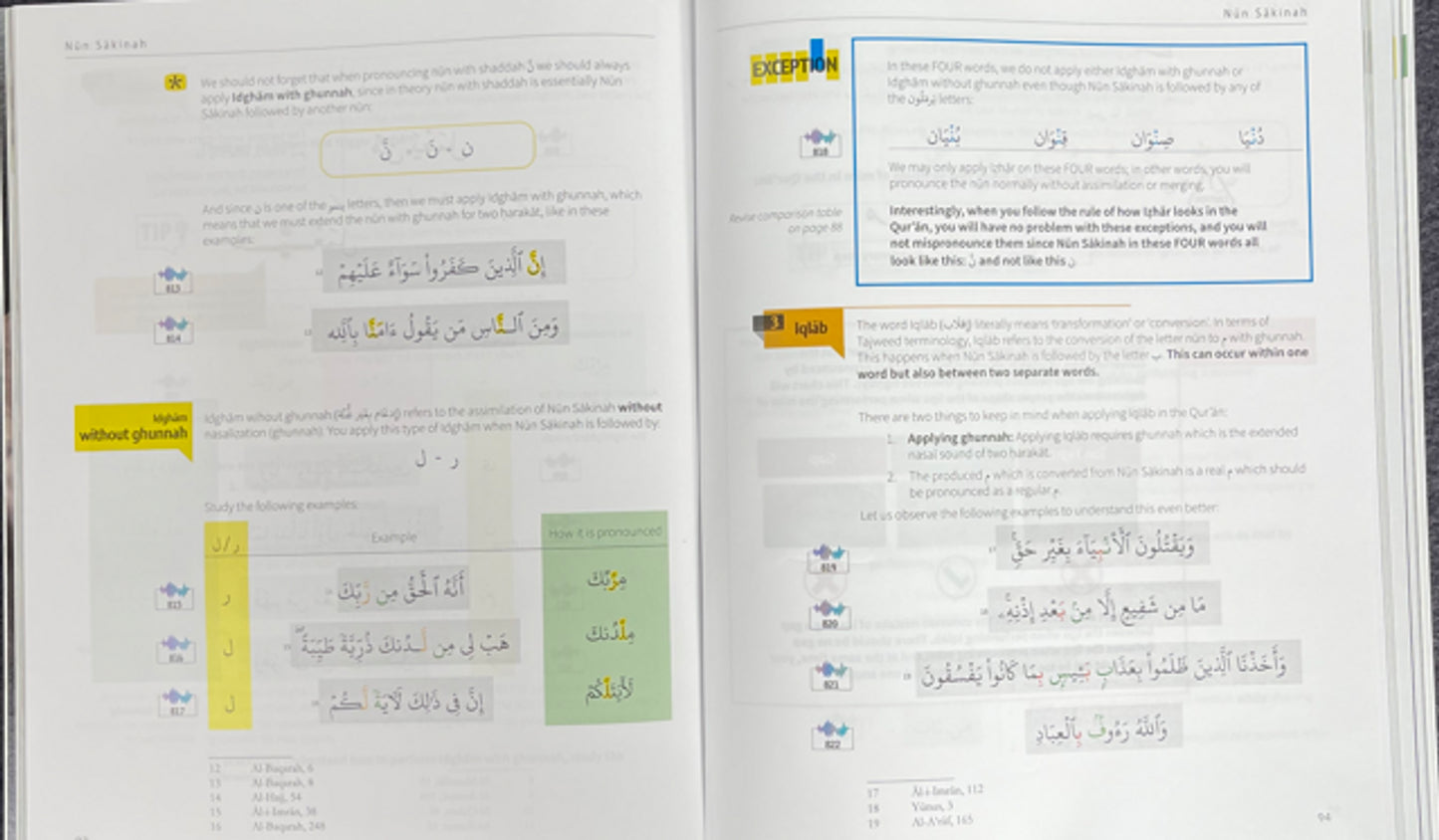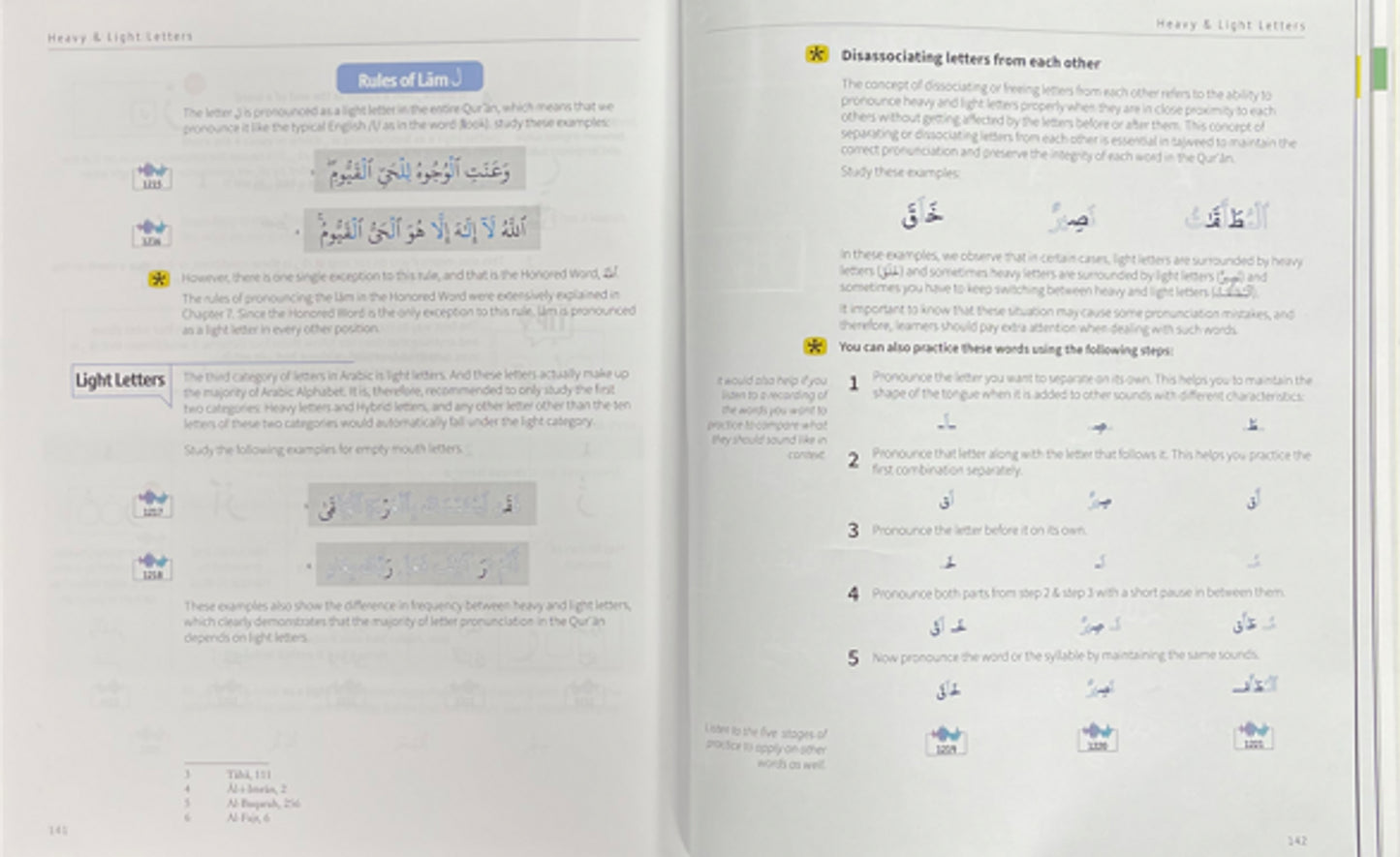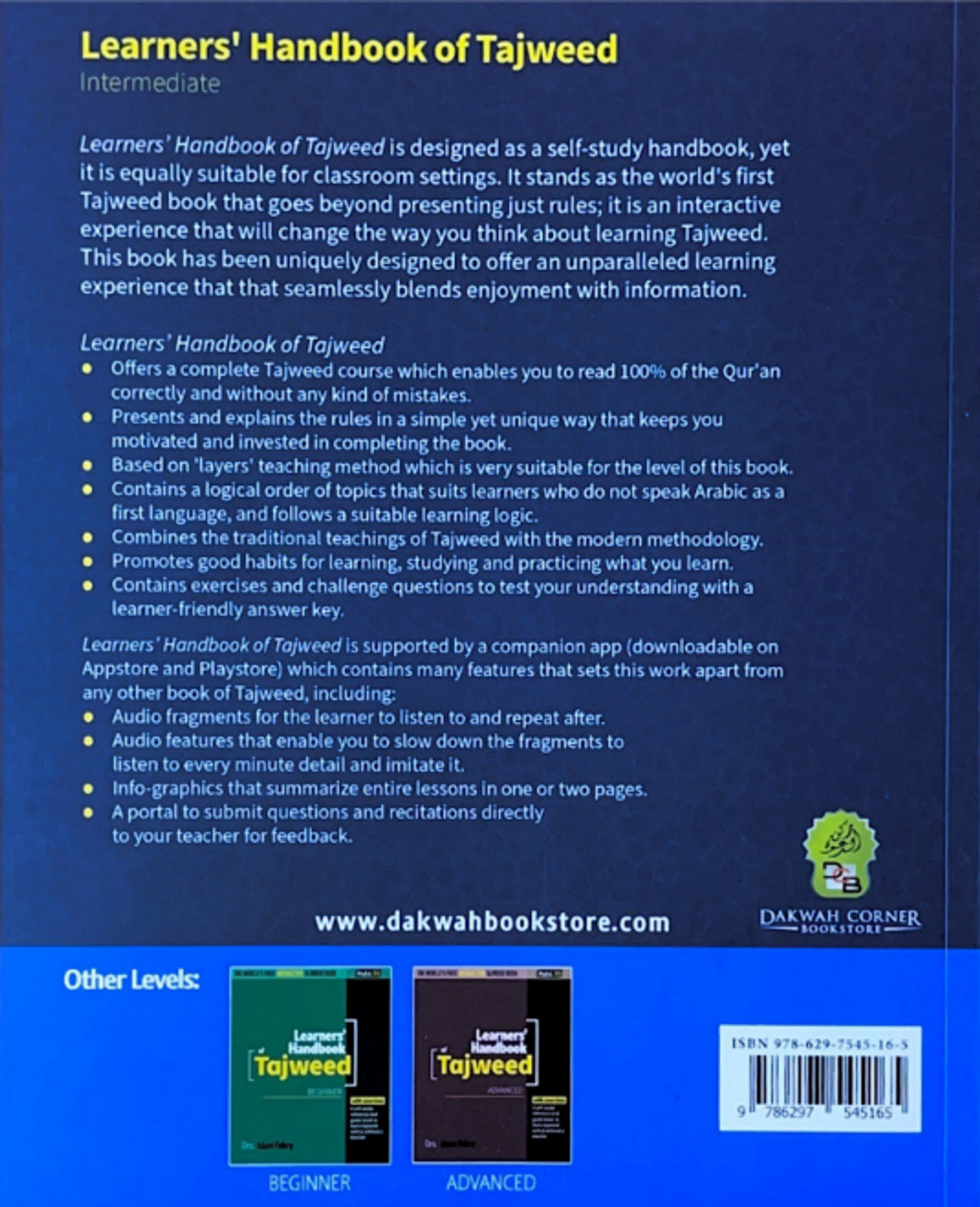Learner's Handbook of Tajweed By Dr Islam Fekry
Learner's Handbook of Tajweed By Dr Islam Fekry
Publisher:
Dakwah Corner Publisher
Author:
Dr Islam Fekry
Language:
English
Binding:
Soft Cover
Pages: 181
Size: A5 |5.8 x 8.3 in| 14.8x 21 cm
Couldn't load pickup availability





Collapsible content
Description of Book
Learner's Handbook of Tajweed By Dr Islam Fekry
Learner's Handbook of Tajweed is a comprehensive guide designed to help students refine their understanding and practice of Tajweed, the rules for correct pronunciation and recitation of the Quran. This book is tailored for those who have mastered the basics of Tajweed and are ready to move into more advanced stages of learning. It focuses on intermediate-level rules, providing clear explanations and practical examples to enhance the learner’s ability to recite the Quran with precision and beauty.
The book includes detailed lessons on the articulation points of Arabic letters, the correct application of nasal sounds, and the rules of elongation, pauses, and breathing. It also covers common mistakes made by learners at this stage and offers exercises to help improve accuracy. The aim is to bridge the gap between theoretical knowledge and practical application, ensuring that students not only understand the rules of Tajweed but can also apply them effortlessly in their recitation.
Perfect for students, teachers, and anyone looking to deepen their Tajweed knowledge, this handbook encourages a disciplined and consistent approach to learning, helping readers develop a closer connection with the Quran through proper recitation.
Publisher
Dakwah Corner Publisher
Author
- Dr Islam Fekry
Sample Pages - Content
Page : 01
THE WORLD'S FIRST INTERACTIVE TAJWEED BOOK AUDIO FEATURES ON A Arabic 101 of Learners' Handbook Tajweed INTERMEDIATE Drs. Islam Fekry with exercises A self-study reference and guide book to learn tajweed with & without a teacher
Page : 02
DISCUSSION Follow these steps to learn Chapter & effectively 1. Study the rules of Hamzah carefully 2. Use the attached poster to easily detect the two types of hamuh 1 As you apply the rules of this lesson, remember to apply all the previous rules that you learned so far Task 1: Read this Byt from Surah Al Qiyamah, and answer the following questions لا إِذَا بَلَغَتِ التراقِي وَقِيلَ مَنْ رَاقِ وَظَنَّ أَنَّهُ الْفِرَاقُ والتفَّتِ السَّاق بالساقية إلى رَبِّكَ يَوْمَيذٍ الْمَسَاقُ 1. Find and idently every hamzah in these y 2. What is the best way to recite ayah 27 3. We should pronounce the word reading What are these two ways? in two different ways, depending on whether we stop or keep on Task 3: Read this Syah from Sarah Hüd أركض برجُلِكَ هَذَا مُعْتَسَلْ بَارِدٌ وَشَرَابٌ 1. How can you start reciting at the word Task 4: Decide which short vowel should Hamaat Al-Wal receive at the beginning of these verbs. ارْتَضَى اشكُرُوا اشْمَأَرَتْ ارْتَقِبُوا از گب اجْعَلْ أصْطفيه ادْخُلُوا الغفير اسْتَزَلَّهُمُ Challenge Question Study these iyit 1-8 from Sirah An-Naat: والتَنزِعَت غَرْقَا وَالنَّشِطَتِ نَشْطَان وَالسَّبِحَتِ سَبْحًا ن فَالسَّبِلَاتِ سَبْقَا فَالْمُدَبَرَت أَمْرًا يَوْمَ تَرْجُفُ الرَّاجِفَةُ ) تَتْبَعُهَا الرَّادِفَهُ قُلُوبٌ يَوْمَيذٍ وَاجِفَةً © Task 2: Decide which words have Hamzat Al Wasl, and which have Hamzat Al-Qat: Then pronunce them accordingly. Recite these by it without pausing between them. Recite them one more time while following the sunnah by stopping at each Syah. What changed in your recitation? Now compare your recitation to a recording of your choice for Surah An-Nazi'at الصنيئُونَ ماتيكة الإنجيل الآخرِ يُؤْفَكُونَ أولتيك أَخْطَأْنَا تَفْتَوا لینس بِالْمَعْرُوفِ deni62 mb Hamzah 746
Page : 03
Non Sakinah We should not forget that when pronouncing nun with shaddah 3 we should always apply Idghans with ghunnah, since in theory non with shaddah is essentially Nün Skinah followed by another nonc EXCEPTION Nin Sakinah In these FOUR words, we do not apply either idgham with ghunnah or Idgham without ghunnah even though Non Sakinah is followed by any of letters برمتون the 613 814 And since is one of the letters, then we must apply idgham with ghunnah, which means that we must edend the non with ghunnah for two harakat, like in these eampies إِنَّ الَّذِينَ كَفَرُوا سَوَاءٌ عَلَيْهِمْ ومِنَ النَّاسِ مَن يَقُولُ دَامَنَا بِالله My ghim whout ghumnah without ghunnah refers to the assimilation of Nün Sakinah without asalization (ghunnah) You apply this type of idgham when Nün Sakinah is followed by 1813 817 Study the following examples راد 12 73 14 75 15 Example رل 838 Revt comparison toble on page 88 31 Iqlib How it is pronounced 819 مربك الما ملدنك هَبْ لِي مِن لَّدُنكَ ذُريَّة طَيِّبَةٌ . ل الأبتلكم إِنَّ فِي ذَلِكَ لَآيَة أَكُمْ - ل A-Bagan, 6 Al Barsh Al-Ha54 Alileri, 38 N- Bagh, 245 120 821 122 بنيان قنوان صنوان دلها We may only apply thar on these FOUR words, in other words, you will pronounce the nun normally without assimilation or merging Interestingly, when you follow the rule of how ghar locks in the Qur'an, you will have no problem with these exceptions, and you will not mispronounce them since Nún Sakinah in these FOUR words all look like this and not like this The word Iqlab flag Sterally means transformation or conversion in terms of Tajweed terminology, lqlab refers to the conversion of the letter nün to with ghunnah This happens when Nün Sakinah is followed by the letter. This can occur within one word but also between two separate words. There are two things to keep in mind when applying lab in the Qur'an Applying ghunnah: Applying iqlab requires ghunnah which is the extended nasal sound of two barakat 2. The produced, which is converted from Nin Sakinah is a real which should be pronounced as a regular Let us observe the following examples to understand this even better وَيَقْتُلُونَ الْأَنْبِيَاءَ بِغَيْرِ حَلى مَا مِن شَفِيعٍ إِلَّا مِنْ بَعْدِ إِذْنِهِ. وَأَخَذْنَا الَّذِينَ ظَلَمُوا بِعَذَابٍ بيبي بِمَا كَانُوا يَفْسُقُونَ واملة زئول بالعناد 17 Ali berlin 112 75 Yin 3 19 ARAC 165
Page : 04
Heavy & Light Letters 141 1215 Heavy & Light Letters Rules of Lim J The letter is pronounced as a light letter in the entire Quran, which means that we pronounce it like the typical English /Vas in the word Rock) study these examples: وَعَنَتِ الْوُجُوهُ لِلْحَيِّ الْقَيُّوم اللهُ لَا إِلَهَ إِلَّا هُوَ الْحَيُّ الْقَيُّومُ Disassociating letters from each other The concept of dissociating or freeing letters from each other refers to the ability to pronounce heavy and light letters properly when they are in close proximity to each others without getting affected by the letters before or after them. This concept of separating or dissociating letters from each other is essential in tajweed to maintain the comect pronunciation and preserve the integrity of each word in the Quran Study these examples خاق أصير النطاقي However, there is one single exception to this tule, and that is the Honored Word The rules of pronouncing the Um in the Honored Word were extensively explained in Chapter 7. Since the Honored Word is the only exception to this rule. Um is pronounced as a light letter in every other position Light Letters The third category of letters in Arabic is light letters. And these letters actually make up the majority of Arabic Alphabet, it is, therefore, recommended to only study the first beo catingories Heavy leters and Hybrid letters, and any other letter other than the sen leters of these two categories would automatically fall under the light category Study the following examples for empty mouth letters g in these examples, we observe that in certain cases, light letters are surrounded by heavy letters () and sometimes heavy letters are surrounded by light letters sometimes you have to keep switching between heavy and light letters and it important to know that these situation may cause some pronunciation mistakes, and therefore, leamers should pay extra attention when dealing with such words You can also practice these words using the following steps: twould also help you 1 Pronounce the letter you want to separate on its own. This helps you to maintain the shape of the tongue when it is added to other sounds with different characteristics: Siden to recording of practice to compare what Pey should sound like in con 2 Pronounce that letter along with the letter that follows it. This helps you practice the first combination separately. 3 Pronounce the letter before it on its own 1258 These examples also show the difference in frequency between heavy and light letters, which clearly demonstrates that the majority of letter pronunciation in the Quran depends on light letters کے 4 Pronounce both parts from step 2 & step 3 with a short pause in between them. ح أي ک طلاق 4 TIM 111 Nein, 2 Al-Bah, 256 Leter to the five stages of proctice to apply on other word as well 5 Now pronounce the word or the syllable by maintaining the same sounds Jx 1209 342
Page : 05
Learners' Handbook of Tajweed Intermediate Learners' Handbook of Tajweed is designed as a self-study handbook, yet it is equally suitable for classroom settings. It stands as the world's first Tajweed book that goes beyond presenting just rules; it is an interactive experience that will change the way you think about learning Tajweed. This book has been uniquely designed to offer an unparalleled learning experience that that seamlessly blends enjoyment with information. Learners' Handbook of Tajweed • Offers a complete Tajweed course which enables you to read 100% of the Qur'an correctly and without any kind of mistakes. • Presents and explains the rules in a simple yet unique way that keeps you motivated and invested in completing the book. • Based on 'layers' teaching method which is very suitable for the level of this book. • Contains a logical order of topics that suits learners who do not speak Arabic as a first language, and follows a suitable learning logic. • Combines the traditional teachings of Tajweed with the modern methodology. Promotes good habits for learning, studying and practicing what you learn. Contains exercises and challenge questions to test your understanding with a learner-friendly answer key. Learners' Handbook of Tajweed is supported by a companion app (downloadable on Appstore and Playstore) which contains many features that sets this work apart from any other book of Tajweed, including: • Audio fragments for the learner to listen to and repeat after. • Audio features that enable you to slow down the fragments to listen to every minute detail and imitate it. • Info-graphics that summarize entire lessons in one or two pages. A portal to submit questions and recitations directly to your teacher for feedback. www.dakwahbookstore.com DAKWAH CORNER BOOKSTORE Other Levels: Learners Handbook Tajweed OWER Learners Handbook Tajweed ISBN 978-629-7545-16-5 Man Fadry BEGINNER ADVANCED 9 786297 545165
Dr Islam Fekry
Dr. Islam Fekry is an esteemed Islamic scholar and educator, specializing in Quranic studies and Tajweed. With extensive knowledge in the field of Quranic recitation, Dr. Fekry is known for his practical approach to teaching Tajweed, helping students master the correct pronunciation and rules of reciting the Quran. He has authored several educational resources that make the study of Tajweed accessible to learners of all levels, offering clarity and insight into the nuances of Quranic recitation. His work has been influential in spreading a deeper understanding of proper Quranic recitation across the Muslim world.





